Deck 2: Ancient Mesopotamia and Persia
Question
Question
Question
Question
Question
Question
Question
Question
Question
Question
Question
Question
Question
Question
Question
Question
Question
Question
Question
Question
Question
Question
Question
Question
Question
Question
Question
Question
Question
Question
Question
Question
Question
Question
Question
Question
Question
Question
Question
Question
Question
Question
Question
Question
Question
Question
Question
Question
Question
Question

Unlock Deck
Sign up to unlock the cards in this deck!
Unlock Deck
Unlock Deck
1/50
Play
Full screen (f)
Deck 2: Ancient Mesopotamia and Persia
1
What epic poem recounts the exploits of a legendary king of Uruk and slayer of the monster Huwawa?
A) The Iliad
B) Epic of Gilgamesh
C) Herodotus: The Histories
D) The Story of Roxanne
A) The Iliad
B) Epic of Gilgamesh
C) Herodotus: The Histories
D) The Story of Roxanne
B
2
Who is the subject of the narrative reliefs in the Assyrian palace at Nimrud?
A) Sargon IV
B) Marduk I
C) Darius
D) Ashurnasirpal II
A) Sargon IV
B) Marduk I
C) Darius
D) Ashurnasirpal II
D
3
Who placed many statues of himself in temples to render his perpetual service to the gods?
A) Hammurabi
B) Urnanshe
C) Gudea
D) Naram-Sin
A) Hammurabi
B) Urnanshe
C) Gudea
D) Naram-Sin
C
4
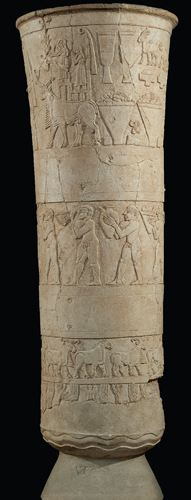
On the Warka Vase, shown here, what is the purpose of the hierarchy of scale?
A) To indicate that those figures are closer to the viewer
B) To show the greater importance of the king and priestess
C) To emphasize the wealth of the dedicant of the vase
D) To most efficiently fill the relief surface with decoration

On the Warka Vase, shown here, what is the purpose of the hierarchy of scale?
A) To indicate that those figures are closer to the viewer
B) To show the greater importance of the king and priestess
C) To emphasize the wealth of the dedicant of the vase
D) To most efficiently fill the relief surface with decoration

Unlock Deck
Unlock for access to all 50 flashcards in this deck.
Unlock Deck
k this deck
5
Which of the following advances was not a significant contribution of the Sumerians?
A) The invention of writing
B) The bent-axis plan
C) The city-state
D) The defensive fortification wall
A) The invention of writing
B) The bent-axis plan
C) The city-state
D) The defensive fortification wall

Unlock Deck
Unlock for access to all 50 flashcards in this deck.
Unlock Deck
k this deck
6
What prior event might have motivated Alexander the Great to raze Persepolis in 330 BCE?
A) The destruction of the Assyrian city of Nimrud
B) The founding of the Sasanian dynasty
C) The Persian sack of the Athenian Acropolis
D) The Persian sack of the fortress of Jericho
A) The destruction of the Assyrian city of Nimrud
B) The founding of the Sasanian dynasty
C) The Persian sack of the Athenian Acropolis
D) The Persian sack of the fortress of Jericho

Unlock Deck
Unlock for access to all 50 flashcards in this deck.
Unlock Deck
k this deck
7
The rods and ring connoting the ruler's capacity to build social order and render judgments are highlighted on which monument?
A) Standard of Ur
B) Stele of Naram-Sin
C) Stele of the Vultures
D) Stele of Hammurabi
A) Standard of Ur
B) Stele of Naram-Sin
C) Stele of the Vultures
D) Stele of Hammurabi

Unlock Deck
Unlock for access to all 50 flashcards in this deck.
Unlock Deck
k this deck
8
How do Persian palatial reliefs differ from Assyrian reliefs?
A) Persian reliefs are flatter with lightly incised lines.
B) Persian reliefs are more rounded and project more from the surface.
C) Persian reliefs make a point of emphasizing the eyes.
D) Persian reliefs highlight nudity and muscularity.
A) Persian reliefs are flatter with lightly incised lines.
B) Persian reliefs are more rounded and project more from the surface.
C) Persian reliefs make a point of emphasizing the eyes.
D) Persian reliefs highlight nudity and muscularity.

Unlock Deck
Unlock for access to all 50 flashcards in this deck.
Unlock Deck
k this deck
9
What do art historians believe is the purpose of the eye shape of Sumerian votive sculptures?
A) Their eyes are narrowed in response to mystical visions.
B) Their eyes are closed to indicate knowledge and wisdom
C) The rounded shape of the eyes indicates their divine nature.
D) The enlarged and rounded eyes indicate their eternal wakefulness.
A) Their eyes are narrowed in response to mystical visions.
B) Their eyes are closed to indicate knowledge and wisdom
C) The rounded shape of the eyes indicates their divine nature.
D) The enlarged and rounded eyes indicate their eternal wakefulness.

Unlock Deck
Unlock for access to all 50 flashcards in this deck.
Unlock Deck
k this deck
10
Column capitals in the shapes of bull heads were characteristic of which region?
A) Assyria
B) Babylonia
C) Syria
D) Persia
A) Assyria
B) Babylonia
C) Syria
D) Persia

Unlock Deck
Unlock for access to all 50 flashcards in this deck.
Unlock Deck
k this deck
11
What determined the orientation of the White Temple at Uruk?
A) The midpoint of the Orion constellation
B) The cardinal points of the compass
C) The direction of the Tigris and Euphrates Rivers
D) The position the rising sun on the king's birthday
A) The midpoint of the Orion constellation
B) The cardinal points of the compass
C) The direction of the Tigris and Euphrates Rivers
D) The position the rising sun on the king's birthday

Unlock Deck
Unlock for access to all 50 flashcards in this deck.
Unlock Deck
k this deck
12
What monument embodies Nebuchadnezzar II's goal of beautifying his city?
A) The White Temple at Ur
B) The ziggurat at Ur
C) The Ishtar Gate at Babylon
D) The palace at Persepolis
A) The White Temple at Ur
B) The ziggurat at Ur
C) The Ishtar Gate at Babylon
D) The palace at Persepolis

Unlock Deck
Unlock for access to all 50 flashcards in this deck.
Unlock Deck
k this deck
13
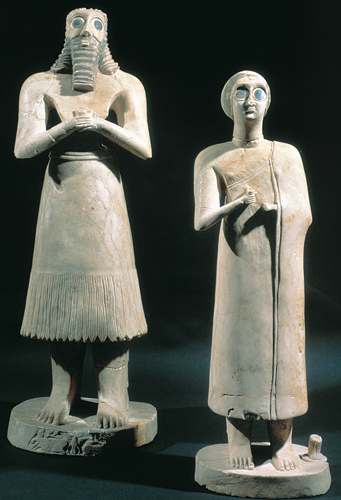
What was the purpose of these statuettes from the Square Temple at Eshnunna?
A) They were placed in the tomb to entertain the deceased in the afterlife.
B) They were placed in temples as dedications expressing gratitude to deities.
C) They accompanied the deceased in the tomb to offer prayers to deities.
D) They served as witnesses in the proceedings of law courts.

What was the purpose of these statuettes from the Square Temple at Eshnunna?
A) They were placed in the tomb to entertain the deceased in the afterlife.
B) They were placed in temples as dedications expressing gratitude to deities.
C) They accompanied the deceased in the tomb to offer prayers to deities.
D) They served as witnesses in the proceedings of law courts.

Unlock Deck
Unlock for access to all 50 flashcards in this deck.
Unlock Deck
k this deck
14
What is the thematic emphasis of the murals that decorated Assyrian palaces?
A) The religious devotion of the people of the court
B) The expectations for the afterlife
C) The building program of the city
D) The assertion of royal power
A) The religious devotion of the people of the court
B) The expectations for the afterlife
C) The building program of the city
D) The assertion of royal power

Unlock Deck
Unlock for access to all 50 flashcards in this deck.
Unlock Deck
k this deck
15
What was the function of the ziggurat at Ur?
A) It was a fortified citadel.
B) It was a burial ground.
C) It was a palatial compound.
D) It was a temple platform.
A) It was a fortified citadel.
B) It was a burial ground.
C) It was a palatial compound.
D) It was a temple platform.

Unlock Deck
Unlock for access to all 50 flashcards in this deck.
Unlock Deck
k this deck
16
The Sasanian leader Shapur I set up a number of reliefs at Bishapur that showed him accomplishing what feat?
A) Capturing the emperor of the Han dynasty
B) Bringing captives to Babylon
C) Capturing the emperor Valerian
D) Leading his soldiers in battle
A) Capturing the emperor of the Han dynasty
B) Bringing captives to Babylon
C) Capturing the emperor Valerian
D) Leading his soldiers in battle

Unlock Deck
Unlock for access to all 50 flashcards in this deck.
Unlock Deck
k this deck
17
What Mesopotamian king codified the law and prescribed penalties for infractions?
A) Urnanshe
B) Hammurabi
C) Gudea
D) Naram-Sin
A) Urnanshe
B) Hammurabi
C) Gudea
D) Naram-Sin

Unlock Deck
Unlock for access to all 50 flashcards in this deck.
Unlock Deck
k this deck
18
What is the significance of the polished diorite used for many sculpted portraits of Gudea?
A) The stone symbolizes death.
B) The stone symbolizes military victory
C) The stone is easily shaped and carved.
D) The material was costly to acquire.
A) The stone symbolizes death.
B) The stone symbolizes military victory
C) The stone is easily shaped and carved.
D) The material was costly to acquire.

Unlock Deck
Unlock for access to all 50 flashcards in this deck.
Unlock Deck
k this deck
19
What information does the victory stele of Eannatum ( Stele of the Vultures ) provide about the nature of the ensi, or leader?
A) The hierarchy of scale of the figures on the relief proves the ruler is equal to the soldiers.
B) The god Ningirsu was opposed to Eannatum ruling Lagash and sought to thwart him.
C) The ensi is the fearless general who paves the way for his soldiers against the enemy.
D) The ensi is chosen by the gods to rule over the kingdom of the Akkadians.
A) The hierarchy of scale of the figures on the relief proves the ruler is equal to the soldiers.
B) The god Ningirsu was opposed to Eannatum ruling Lagash and sought to thwart him.
C) The ensi is the fearless general who paves the way for his soldiers against the enemy.
D) The ensi is chosen by the gods to rule over the kingdom of the Akkadians.

Unlock Deck
Unlock for access to all 50 flashcards in this deck.
Unlock Deck
k this deck
20
The Ishtar Gate, with its glazed tile decorations, was built at which city?
A) Lagash
B) Babylon
C) Persepolis
D) Ur
A) Lagash
B) Babylon
C) Persepolis
D) Ur

Unlock Deck
Unlock for access to all 50 flashcards in this deck.
Unlock Deck
k this deck
21
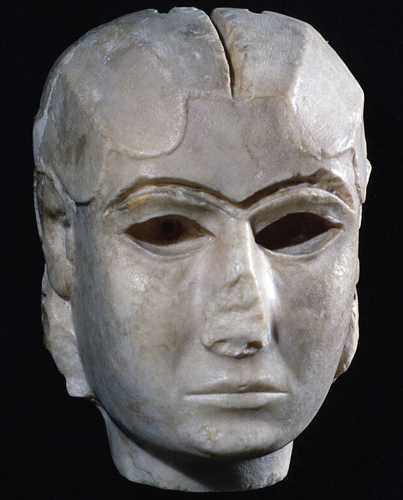
Of the original components that made up this statue, which used the rarest material?
A) Gold-leaf wig
B) Wood body
C) Marble face
D) Embroidered garment

Of the original components that made up this statue, which used the rarest material?
A) Gold-leaf wig
B) Wood body
C) Marble face
D) Embroidered garment

Unlock Deck
Unlock for access to all 50 flashcards in this deck.
Unlock Deck
k this deck
22
The Gate of All Lands, the monumental gateway to the citadel of Persepolis, is a reference to what reality?
A) The harmony of the peoples of the Sasanian empire
B) The harmony of the peoples of the Persian empire
C) The harmony of the peoples of the Assyrian empire
D) The compass points on which the entrance is aligned
A) The harmony of the peoples of the Sasanian empire
B) The harmony of the peoples of the Persian empire
C) The harmony of the peoples of the Assyrian empire
D) The compass points on which the entrance is aligned

Unlock Deck
Unlock for access to all 50 flashcards in this deck.
Unlock Deck
k this deck
23
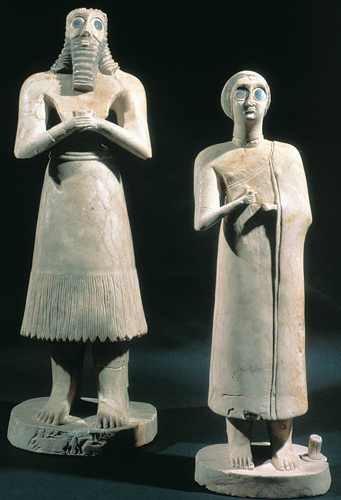
Which civilization created the statues seen here?
A) Akkad
B) Hattusa
C) Elam
D) Sumer

Which civilization created the statues seen here?
A) Akkad
B) Hattusa
C) Elam
D) Sumer

Unlock Deck
Unlock for access to all 50 flashcards in this deck.
Unlock Deck
k this deck
24
What do art historians call the large composite creatures that guarded the gates of Assyrian royal complexes?
A) Sphinxes
B) Griffins
C) Huwawa
D) Lamassu
A) Sphinxes
B) Griffins
C) Huwawa
D) Lamassu

Unlock Deck
Unlock for access to all 50 flashcards in this deck.
Unlock Deck
k this deck
25
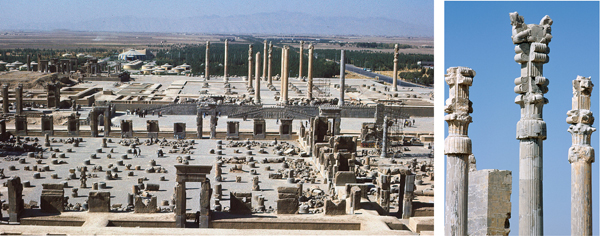
What term connotes the royal audience hall shown here?
A) Hypostyle
B) Cella
C) Apadana
D) Plaza

What term connotes the royal audience hall shown here?
A) Hypostyle
B) Cella
C) Apadana
D) Plaza

Unlock Deck
Unlock for access to all 50 flashcards in this deck.
Unlock Deck
k this deck
26
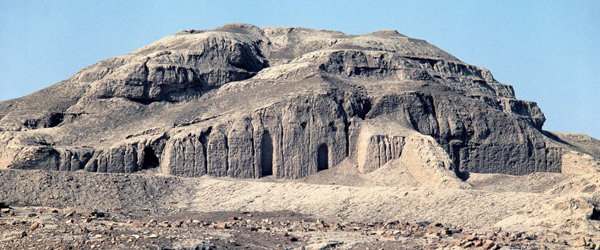
What monument is represented here?
A) The Ishtar Gate of Babylon
B) The White Temple at Uruk
C) The ziggurat at Ur
D) The Hanging Gardens of Babylon

What monument is represented here?
A) The Ishtar Gate of Babylon
B) The White Temple at Uruk
C) The ziggurat at Ur
D) The Hanging Gardens of Babylon

Unlock Deck
Unlock for access to all 50 flashcards in this deck.
Unlock Deck
k this deck
27
The Palace of Sargon II and the Palace of Ashurnasirpal II were built by which people?
A) Akkadians
B) Sumerians
C) Assyrians
D) Elamites
A) Akkadians
B) Sumerians
C) Assyrians
D) Elamites

Unlock Deck
Unlock for access to all 50 flashcards in this deck.
Unlock Deck
k this deck
28
Which of the following works of art was created first?
A) Standard of Ur
B) Warka Vase
C) Stele of the Vultures
D) Stele of Hammurabi
A) Standard of Ur
B) Warka Vase
C) Stele of the Vultures
D) Stele of Hammurabi

Unlock Deck
Unlock for access to all 50 flashcards in this deck.
Unlock Deck
k this deck
29
What are the subjects of the two sides of the Standard of Ur ?
A) Farming and hunting
B) War and peace
C) Family life and community life
D) Rural life and urban life
A) Farming and hunting
B) War and peace
C) Family life and community life
D) Rural life and urban life

Unlock Deck
Unlock for access to all 50 flashcards in this deck.
Unlock Deck
k this deck
30
What is a rhyton?
A) A back-to-back animal sculpture
B) An arch-shaped doorway
C) An eagle-headed winged lion
D) A conical pouring vessel
A) A back-to-back animal sculpture
B) An arch-shaped doorway
C) An eagle-headed winged lion
D) A conical pouring vessel

Unlock Deck
Unlock for access to all 50 flashcards in this deck.
Unlock Deck
k this deck
31
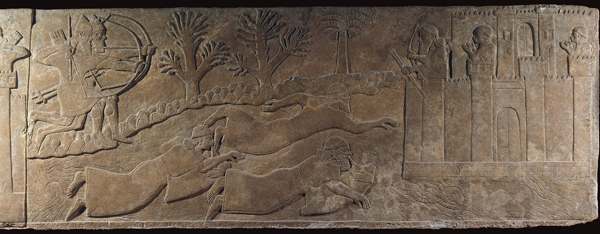
What is the story told by this relief?
A) Alexander destroys the palace at Persepolis.
B) Archers defend the ziggurat at Ur.
C) Sumerians drive the Elamites into the Tigris River.
D) Assyrians drive enemy forces into the Euphrates River.

What is the story told by this relief?
A) Alexander destroys the palace at Persepolis.
B) Archers defend the ziggurat at Ur.
C) Sumerians drive the Elamites into the Tigris River.
D) Assyrians drive enemy forces into the Euphrates River.

Unlock Deck
Unlock for access to all 50 flashcards in this deck.
Unlock Deck
k this deck
32
Because the statue was meant to be both a frontal view and a profile view, how many legs does the lamassu figure have?
A) Six
B) Five
C) Four
D) Three
A) Six
B) Five
C) Four
D) Three

Unlock Deck
Unlock for access to all 50 flashcards in this deck.
Unlock Deck
k this deck
33
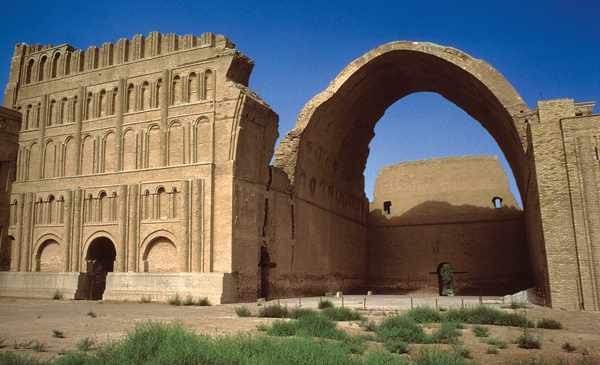
Who were the creators of this palace at Ctesiphon?
A) Persians
B) Sasanians
C) Romans
D) Parthians

Who were the creators of this palace at Ctesiphon?
A) Persians
B) Sasanians
C) Romans
D) Parthians

Unlock Deck
Unlock for access to all 50 flashcards in this deck.
Unlock Deck
k this deck
34
What decorative details of the bull's head harp and the Standard of Ur are the same?
A) Both narrate fantastical scenes.
B) Both display carved scenes of battle.
C) Both display inlaid scenes in registers.
D) Both narrate the deeds of Gilgamesh.
A) Both narrate fantastical scenes.
B) Both display carved scenes of battle.
C) Both display inlaid scenes in registers.
D) Both narrate the deeds of Gilgamesh.

Unlock Deck
Unlock for access to all 50 flashcards in this deck.
Unlock Deck
k this deck
35
What event ended the Achaemenid empire?
A) The Greek defeat of the Persians in 479 BCE
B) The capture of Babylon by Cyrus in 539 BCE
C) The death of Darius III after his defeat in 330 BCE
D) The defeat of the Parthians by Ardashir I in 224 CE
A) The Greek defeat of the Persians in 479 BCE
B) The capture of Babylon by Cyrus in 539 BCE
C) The death of Darius III after his defeat in 330 BCE
D) The defeat of the Parthians by Ardashir I in 224 CE

Unlock Deck
Unlock for access to all 50 flashcards in this deck.
Unlock Deck
k this deck
36
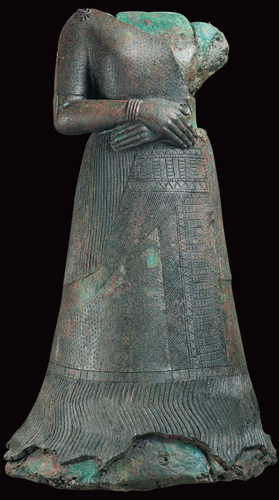
What accounts for the great weight of this statue?
A) The king wanted to consolidate his wealth in one object.
B) The patron wanted it to be a permanent and immovable dedication.
C) The artist wanted it to be a permanent and immovable dedication.
D) The metal used to create it is extremely dense and heavy.

What accounts for the great weight of this statue?
A) The king wanted to consolidate his wealth in one object.
B) The patron wanted it to be a permanent and immovable dedication.
C) The artist wanted it to be a permanent and immovable dedication.
D) The metal used to create it is extremely dense and heavy.

Unlock Deck
Unlock for access to all 50 flashcards in this deck.
Unlock Deck
k this deck
37
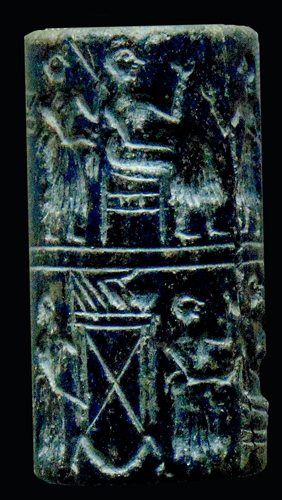
What is this object?
A) A sound box
B) A stele
C) An earring
D) A cylinder seal

What is this object?
A) A sound box
B) A stele
C) An earring
D) A cylinder seal

Unlock Deck
Unlock for access to all 50 flashcards in this deck.
Unlock Deck
k this deck
38
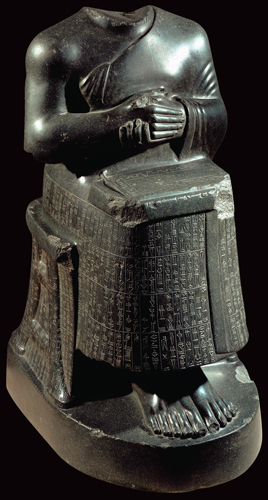
What appears on the lap of the figure in this statue?
A) The gardens of Babylon
B) The colonnade at Persepolis
C) The name of the sculptor
D) A temple plan

What appears on the lap of the figure in this statue?
A) The gardens of Babylon
B) The colonnade at Persepolis
C) The name of the sculptor
D) A temple plan

Unlock Deck
Unlock for access to all 50 flashcards in this deck.
Unlock Deck
k this deck
39
What architectural design feature at Persepolis seems uniquely Persian?
A) Entrance ramps
B) Processing figures
C) Protome capitals
D) Wall reliefs
A) Entrance ramps
B) Processing figures
C) Protome capitals
D) Wall reliefs

Unlock Deck
Unlock for access to all 50 flashcards in this deck.
Unlock Deck
k this deck
40
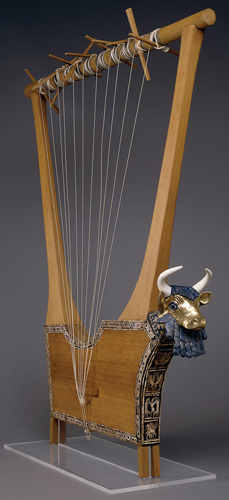
What material makes up the hair and beard of the bull?
A) Bitumen
B) Diorite
C) Lapis lazuli
D) Azurite

What material makes up the hair and beard of the bull?
A) Bitumen
B) Diorite
C) Lapis lazuli
D) Azurite

Unlock Deck
Unlock for access to all 50 flashcards in this deck.
Unlock Deck
k this deck
41
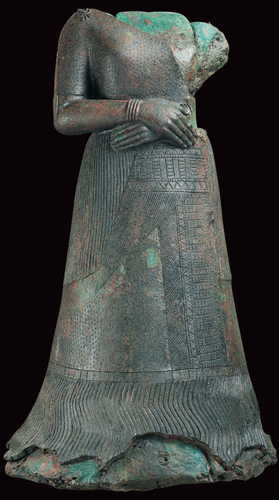
What aspect of this statue makes an allusion to fertility?
A) Upright stance
B) Full, rounded skirt
C) Hands crossed over the belly
D) Inscription on skirt

What aspect of this statue makes an allusion to fertility?
A) Upright stance
B) Full, rounded skirt
C) Hands crossed over the belly
D) Inscription on skirt

Unlock Deck
Unlock for access to all 50 flashcards in this deck.
Unlock Deck
k this deck
42
How many years separate the construction of the White Temple and the construction of the ziggurat at Ur?
A) Two centuries
B) Ten millennia
C) A decade
D) A millennium
A) Two centuries
B) Ten millennia
C) A decade
D) A millennium

Unlock Deck
Unlock for access to all 50 flashcards in this deck.
Unlock Deck
k this deck
43
What is the name of the earliest-known author?
A) Homer
B) Gilgamesh
C) Enheduanna
D) Naram-Sin
A) Homer
B) Gilgamesh
C) Enheduanna
D) Naram-Sin

Unlock Deck
Unlock for access to all 50 flashcards in this deck.
Unlock Deck
k this deck
44
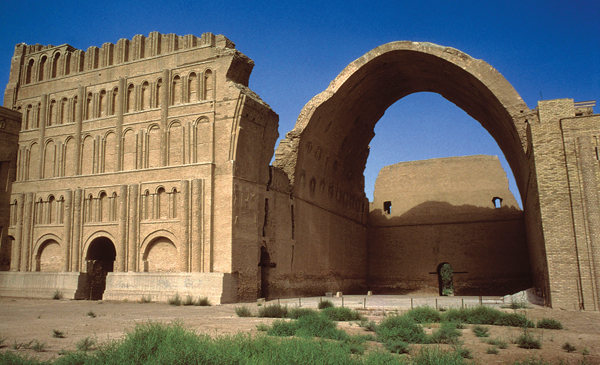
What is the central feature of the Ctesiphon palace, shown here?
A) Apadana
B) Cella
C) Iwan
D) Protome

What is the central feature of the Ctesiphon palace, shown here?
A) Apadana
B) Cella
C) Iwan
D) Protome

Unlock Deck
Unlock for access to all 50 flashcards in this deck.
Unlock Deck
k this deck
45
What term describes the Sumerian writing system?
A) Pictography
B) Hieroglyphic
C) Eshnunna
D) Cuneiform
A) Pictography
B) Hieroglyphic
C) Eshnunna
D) Cuneiform

Unlock Deck
Unlock for access to all 50 flashcards in this deck.
Unlock Deck
k this deck
46
How is Ashurnasirpal II identified in the painted panels from the palace at Kalhu?
A) He wears richly patterned garments.
B) He carries precious offerings for the gods.
C) He is shown in outline and profile view.
D) He is taller than the other figures.
A) He wears richly patterned garments.
B) He carries precious offerings for the gods.
C) He is shown in outline and profile view.
D) He is taller than the other figures.

Unlock Deck
Unlock for access to all 50 flashcards in this deck.
Unlock Deck
k this deck
47
At what Elamite site have archaeologists discovered examples of painted pottery going back to the Neolithic period?
A) Uruk
B) Susa
C) Ctesiphon
D) Babylon
A) Uruk
B) Susa
C) Ctesiphon
D) Babylon

Unlock Deck
Unlock for access to all 50 flashcards in this deck.
Unlock Deck
k this deck
48
What is the subject of the relief on the stele of Hammurabi?
A) The coronation of Hammurabi
B) Divinity grants Hammurabi the right to rule
C) Hammurabi punishes enemies
D) The death of Hammurabi
A) The coronation of Hammurabi
B) Divinity grants Hammurabi the right to rule
C) Hammurabi punishes enemies
D) The death of Hammurabi

Unlock Deck
Unlock for access to all 50 flashcards in this deck.
Unlock Deck
k this deck
49
What materials were used in the construction of the Ishtar Gate?
A) Concrete and blue-glazed tile
B) Mudbrick and blue-gazed tile
C) Mudbrick and lapis lazuli
D) Granite and lapis lazuli
A) Concrete and blue-glazed tile
B) Mudbrick and blue-gazed tile
C) Mudbrick and lapis lazuli
D) Granite and lapis lazuli

Unlock Deck
Unlock for access to all 50 flashcards in this deck.
Unlock Deck
k this deck
50
What was the administrative and economic center of the Sumerian city?
A) The palace
B) The temple
C) The archive
D) The city-state
A) The palace
B) The temple
C) The archive
D) The city-state

Unlock Deck
Unlock for access to all 50 flashcards in this deck.
Unlock Deck
k this deck



